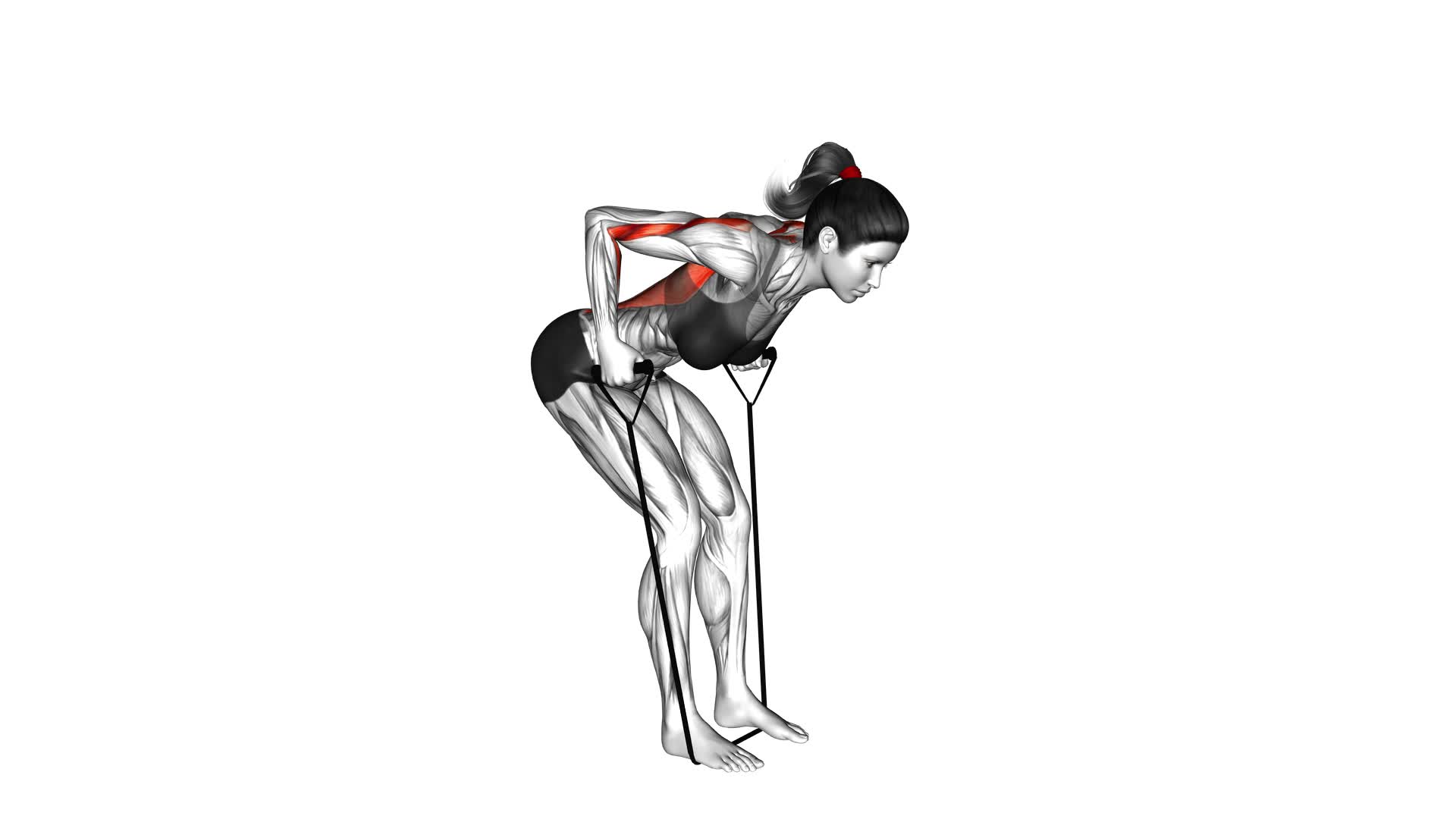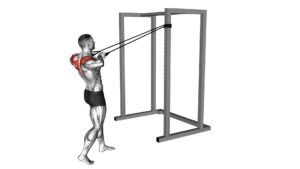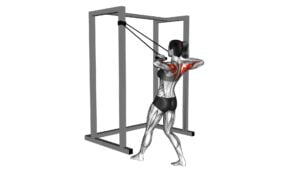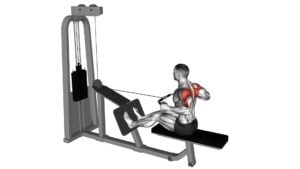Band Rear Delt Row – Video Exercise Guide & Tips

Looking to strengthen your rear deltoids? Check out this video exercise guide for the Band Rear Delt Row.
Watch This Exercise Video
With just a band and a few simple steps, you can target and tone your shoulders effectively. Avoid common mistakes, try different variations, and get the most out of this exercise.
Whether you're a beginner or an experienced athlete, this guide will help you perfect your form and maximize your results.
Let's get started!
Key Takeaways
- The band rear delt row targets and strengthens the rear deltoid muscles, which are often neglected in traditional strength training exercises.
- This exercise is crucial for overall shoulder stability and posture, as it specifically isolates and strengthens the rear deltoids.
- The use of resistance bands provides versatile and portable equipment that builds strength and muscle in the upper back.
- Modifications and variations, such as using dumbbells or a cable machine, can enhance the exercise and target different muscles, while maintaining proper form and avoiding common mistakes.
Benefits of the Band Rear Delt Row
One major benefit of the Band Rear Delt Row is that it targets and strengthens the rear deltoid muscles. The rear deltoids are often neglected in traditional strength training exercises, but they play a crucial role in overall shoulder stability and posture. By incorporating the Band Rear Delt Row into your workout routine, you can specifically isolate and strengthen these muscles, leading to improved upper body strength and stability.
One of the advantages of using resistance bands for this exercise is the constant tension it provides throughout the movement. This constant tension forces your rear deltoids to work harder, leading to increased muscle activation and ultimately better results. Additionally, the Band Rear Delt Row allows for a greater range of motion compared to other exercises, enabling a more thorough contraction of the muscle fibers.
When it comes to results analysis, incorporating the Band Rear Delt Row into your workout routine can lead to improved shoulder strength, increased shoulder stability, and better posture. Strong rear deltoids can also help prevent shoulder injuries, as they assist in stabilizing the shoulder joint during various movements.
Equipment Needed for the Exercise
To perform the Band Rear Delt Row exercise, you'll need just one piece of equipment. That piece of equipment is a resistance band. The resistance band is a versatile and portable tool that allows you to target your rear deltoid muscles effectively. It provides resistance throughout the movement, helping to build strength and muscle in your upper back.
If you don't have a resistance band, there are a few exercise modifications you can try. One option is to use dumbbells instead. You can perform a bent-over row with dumbbells, focusing on squeezing your shoulder blades together as you lift the weights. Another alternative is to use a cable machine with a low pulley attachment. Attach a rope handle to the pulley and perform a seated row, pulling the handle towards your body while keeping your elbows close to your sides.
Now that you know the equipment needed for the Band Rear Delt Row exercise, let's move on to the step-by-step guide to performing the exercise.
Step-by-Step Guide to Performing the Band Rear Delt Row
To perform the Band Rear Delt Row, start by attaching a resistance band to a stable anchor point at waist height. Make sure the anchor point is secure to avoid any accidents.
Stand facing the anchor point, with your feet shoulder-width apart and knees slightly bent. Hold the resistance band handles with an overhand grip, palms facing each other. Keep your back straight and engage your core.
Next, pull the resistance band towards your body by retracting your shoulder blades and squeezing your back muscles. Keep your elbows close to your body and focus on pulling with your rear deltoids. Avoid using your biceps or traps to perform the movement.
As you pull the band towards your body, exhale and squeeze your shoulder blades together. Pause for a moment at the fully contracted position, feeling the squeeze in your rear delts. Then, slowly return to the starting position, keeping tension on the band throughout the movement.
Common Mistakes to Avoid
To avoid common mistakes, make sure you attach a resistance band to a secure anchor point at waist height when performing the Band Rear Delt Row. This is crucial because using an unstable anchor point or attaching the band too high or too low can affect your form and reduce the effectiveness of the exercise.
Another common mistake to avoid is using too much momentum. Proper form techniques require you to maintain control throughout the movement, focusing on squeezing your shoulder blades together and engaging your rear delts. Avoid swinging your body or using your lower back to generate momentum.
Additionally, make sure to keep your core engaged and maintain a neutral spine position throughout the exercise. It's important to avoid rounding your shoulders or arching your back, as this can lead to poor form and potential injury.
By paying attention to these common mistakes and focusing on proper form techniques, you can maximize the benefits of the Band Rear Delt Row exercise and avoid unnecessary strain or injury.
Now, let's move on to the next section to explore some variations and modifications to try.
Variations and Modifications to Try
Now let's explore some variations and modifications to enhance the effectiveness of the band rear delt row exercise.
By incorporating different grips or adjusting the resistance level of the band, you can target different muscles and add variety to your workout.
Additionally, focusing on maintaining proper form throughout each repetition is crucial for maximizing results and minimizing the risk of injury.
Enhancing the Exercise
You can enhance the Band Rear Delt Row exercise by trying different variations and modifications. These variations can help improve your results and target different areas of your rear deltoids.
One alternative exercise you can try is the Single Arm Band Rear Delt Row. Instead of using both arms, you'll use one arm at a time, which can increase the intensity and focus on each side of your back.
Another modification you can make is adjusting the resistance level of the band. Using a heavier band can provide a greater challenge, while using a lighter band can allow for higher repetitions.
Additionally, you can experiment with different hand grips and positions to target specific areas of your rear delts.
Remember to always maintain proper form and listen to your body to avoid injury.
Proper Form Techniques
One technique to ensure proper form and maximize results is experimenting with variations and modifications in the Band Rear Delt Row exercise. By doing so, you can target different muscles and avoid common errors that may hinder your progress.
One common error is using too much momentum or swinging your body during the exercise. To fix this, focus on maintaining a stable and controlled movement throughout the entire range of motion.
Another modification to try is using different types of resistance bands to increase or decrease the intensity of the exercise.
Additionally, you can also incorporate alternative exercises such as the bent-over dumbbell row or the seated cable row to further engage your rear delts and back muscles.
Tips for Getting the Most Out of Your Band Rear Delt Row
To maximize the effectiveness of your Band Rear Delt Row, focus on maintaining proper form throughout the exercise. This is crucial for maximizing results and preventing injuries. Here are some tips to help you get the most out of your workout:
- Keep your back straight: Maintaining a neutral spine position is essential. Avoid rounding your back or hunching your shoulders, as this can lead to strain or injury.
- Engage your core: Activate your core muscles by pulling your belly button towards your spine. This will provide stability and support to your entire body during the exercise.
- Squeeze your shoulder blades: As you pull the band towards your body, focus on squeezing your shoulder blades together. This will engage your rear deltoids and ensure proper muscle activation.
- Control the movement: Avoid using momentum or swinging your body. Instead, focus on a slow and controlled movement, emphasizing the contraction of your rear delts.
- Adjust the band tension: Use a band with appropriate tension for your fitness level. Too much tension can lead to poor form, while too little tension may not provide enough resistance for effective muscle activation.
Frequently Asked Questions
How Many Reps and Sets Should I Do When Performing the Band Rear Delt Row?
When performing the band rear delt row, it's important to determine the number of reps and sets based on your fitness goals. Generally, aim for 3-4 sets of 8-12 reps to build strength and muscle endurance.
However, you can adjust the reps and sets according to your preferences and fitness level.
If you don't have resistance bands, you can use dumbbells or cables as alternatives for this exercise.
Can I Replace the Resistance Band With Dumbbells or a Cable Machine for This Exercise?
Yes, you can replace the resistance band with dumbbells or a cable machine for the band rear delt row. The dumbbell variation allows for more control and stability, while the cable machine provides constant tension throughout the movement.
However, using resistance bands has its own benefits, such as accommodating resistance and targeting the smaller muscles in your shoulders.
Experiment with different variations to find what works best for you.
Is It Necessary to Warm up Before Performing the Band Rear Delt Row?
Before performing the band rear delt row, it's important to warm up. Warming up has various benefits, such as increasing blood flow and flexibility, which can help prevent injuries.
If you don't have a resistance band, you can use dumbbells or a cable machine as alternatives. However, it's still recommended to warm up regardless of the equipment used.
Can I Perform This Exercise if I Have a Shoulder Injury?
If you have a shoulder injury, it's important to be cautious when performing the band rear delt row. Consult with a healthcare professional or a qualified trainer to determine if it's safe for you to do this exercise. They can provide modifications or alternative exercises that can help you target your rear delts without aggravating your injury.
Prioritize your safety and always listen to your body during workouts.
How Often Should I Incorporate the Band Rear Delt Row Into My Workout Routine for Optimal Results?
To optimize your results, you should incorporate the band rear delt row into your workout routine regularly. It's not just about how often you do this exercise, but also about incorporating other rear delt exercises into your routine.
Strengthening your rear delts has numerous benefits, such as improving your shoulder stability and posture. So, make sure to include this exercise along with other targeted exercises for well-rounded shoulder development.
Conclusion
In conclusion, the band rear delt row is an effective exercise for targeting the rear deltoid muscles.
By using a resistance band, you can increase the intensity and challenge of the exercise.
It's important to maintain proper form and avoid common mistakes to maximize the benefits of this exercise.
With variations and modifications, you can customize the band rear delt row to suit your fitness level and goals.
Remember to follow these tips for optimal results in your workouts.

Author
Years ago, the spark of my life’s passion ignited in my mind the moment I stepped into the local gym for the first time. The inaugural bead of perspiration, the initial endeavor, the very first surge of endorphins, and a sense of pride that washed over me post-workout marked the beginning of my deep-seated interest in strength sports, fitness, and sports nutrition. This very curiosity blossomed rapidly into a profound fascination, propelling me to earn a Master’s degree in Physical Education from the Academy of Physical Education in Krakow, followed by a Sports Manager diploma from the Jagiellonian University. My journey of growth led me to gain more specialized qualifications, such as being a certified personal trainer with a focus on sports dietetics, a lifeguard, and an instructor for wellness and corrective gymnastics. Theoretical knowledge paired seamlessly with practical experience, reinforcing my belief that the transformation of individuals under my guidance was also a reflection of my personal growth. This belief holds true even today. Each day, I strive to push the boundaries and explore new realms. These realms gently elevate me to greater heights. The unique combination of passion for my field and the continuous quest for growth fuels my drive to break new ground.







